
As long as you know how to do it.
If you know the best type of cage to get and what you need to put inside it, you’re already most of the way there.
You just need a bit more info on how to set up the chinchilla cage and where best to put it.
The hard part is finding that information. At least it was when I first got my chinchilla.
I had a hard time finding a reliable source of info. In the end, I learned everything I needed from the breeder who sold me my chin.
Today, I’m going to make sure you have it much easier. Keep reading for everything you need to know to correctly set up a chinchilla cage.
Contents
How To Set Up A Chinchilla Cage Correctly
As a new chinchilla owner, you have an array of options for setting up your chinchilla’s cage and trying to make the perfect home for your new chin.
I remember when I put together my cage for my chinchilla and started piecing together the accessories and toys. It was a ton of fun!
Now, 4 years later, I still find myself buying random items for her, just to try them. Or, of course, for the purpose of this website and community.
The most significant piece of advice I can give when you are setting up your chinchilla’s cage is that the cage itself matters more than anything.
So that is what we are going to start with.
Find The Best Cage
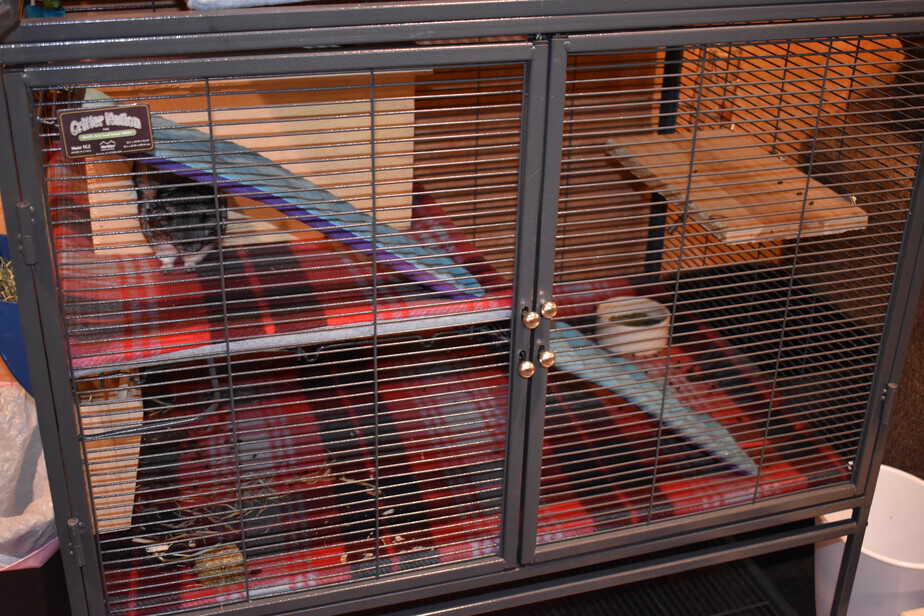
Outside of general nutritional needs for a chinchilla and providing excellent care, the chinchilla cage is the most important purchase you will make.
Chinchillas spend 23 hours per day inside their cages. That’s assuming you get your pet out for 1 hour a day to interact and play with it. Most don’t even give their pets an hour.
That is a long time to be stuck inside of a cage if you ask me.
This, in addition to the way chinchillas are accustomed to behaving and living in the wild, makes it imperative to get a few things right when you purchase your chinchilla cage.
The first is the material. You want to avoid plastic in a chinchilla cage. Apart from that, the most important consideration of all is the size of the cage.
Size Matters
The size of the cage is under-discussed and extremely important. You need a tall enough cage that allows for vertical movement and climbing.
Chinchillas are big fans of jumping and they love acting crazy for a few hours every day. They also enjoy the ability to climb multiple levels.
They need much more vertical space than guinea pigs, for example. Take that into consideration, if you are trying to decide whether to get a chinchilla or guinea pig.
How much are chinchilla cages? Good ones are not cheap, but ensuring you choose the best chinchilla cage is going to make a world of difference for your chinchilla and keep them happy.
Read that article I just linked to. It will help you find the best cage for your needs. The number one recommendation in that article is the cage I use myself.
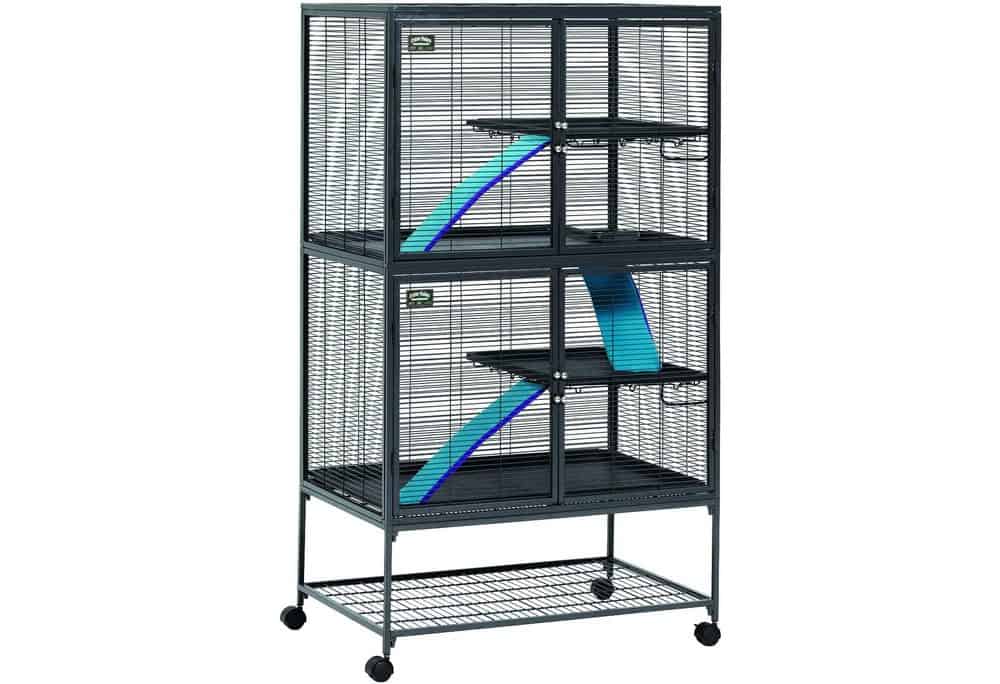
Pick The Right Room
Up next on the list when setting up your chinchilla’s cage is choosing the best room possible for your pet.
You need to consider several things here and all have significant importance.
Perhaps the most important consideration is ensuring that your chinchilla always has the proper temperatures.
To get a full understanding of the temperature guidelines for chinchillas, refer to my post here. This is critical for preventing health conditions such as heat stroke.
Next, you want to ensure that some natural light can enter the room. This will help your chinchilla maintain its proper sleep cycles.
Lastly, you need to understand that a chinchilla will often be active at odd times in the night or early mornings.
This makes it essential for you to choose a room where it will not interrupt your sleep if they begin making noise at night in their cage.
A chinchilla cage should never be covered during the set-up. A chinchilla cage should also not be in your bedroom in most situations.
Ideally, I would also choose a room with hard surface floors. This is going to help dramatically with cleaning up the poop or hay that is discarded out of the cage.
I currently use a basement with hard laminate floors and a window well providing natural light. And the temperature remains at a cool 68 degrees with 2 de-humidifiers always running.
If you do not have air conditioning, it is obviously more difficult to keep your pet at the ideal temperature. Take a look at our 10 tips for keeping chinchillas cool without A/C, if you do not have any type of air conditioning.
Once you have the room chosen and the best cage in place it starts becoming more fun. Let’s move into the bedding options.
Decide On The Type Of Bedding

Do chinchillas need a bed? No. In fact, there really is no such thing as a chinchilla bed. But there is bedding.
And bedding is one of the big decisions you will have when putting together your chinchilla cage. This comes down to a few key factors.
First, your preference is obviously one of the driving factors behind the decision. Secondly, comes your budget, tolerance for odor, and cleaning habits.
The are two primary options. Other things are generally not a good idea. For example, newspaper can work as chinchilla bedding, but it contains ink and other potentially harmful substances.
That’s why I always say to stick to the two main options. The first is traditional bedding used for many rodents. This is typically Aspen shavings.
I used this for about 2 weeks. I have had my chinchilla for 5 years. I could not personally stand it.
It is messy, gets soaked in urine relatively quickly, and falls out of the cage. Not to mention, changing it and cleaning it is a royal pain.
I also hate that you must continue to buy it for as long as your chin lives. This makes it a long-term recurring expense.
I prefer to pay a higher one-time cost up front and be done with it (more on this shortly).
However, it is essential to note that there is absolutely nothing wrong with this bedding. It is safe, approved bedding for chinchillas. You can see my recommendations for the best aspen shavings here.
But when you hear people ask “Are chinchillas messy?”, it’s usually because they’ve heard from someone who uses traditional bedding for theirs. That’s why my preferred option are fleece liners.
Fleece Liners Are King When Setting Up A Chinchilla Cage
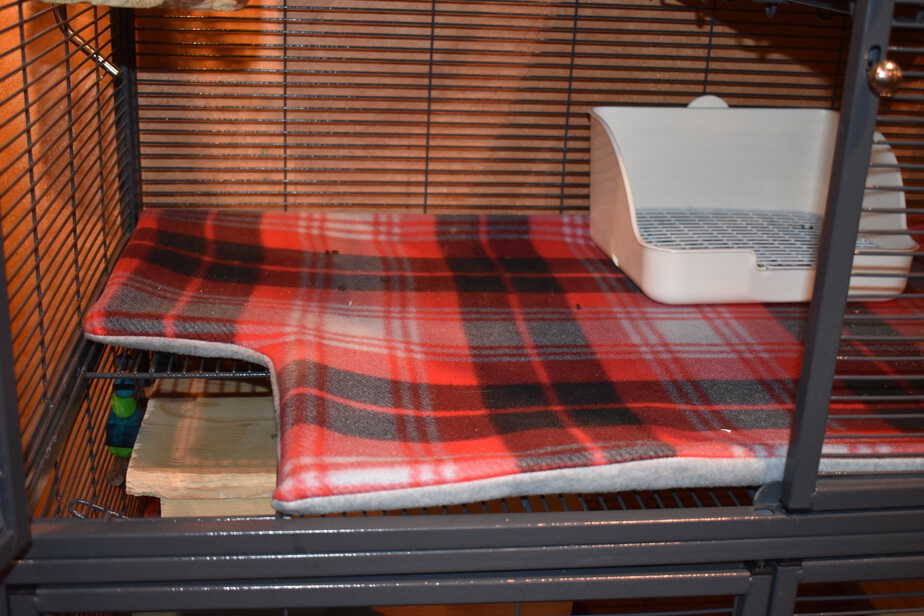
I am sure I will get some push back on this. Some people just do not like the fleece liners for chinchilla bedding because it is not possible to use with all chinchilla cages.
Do you know how you fix this problem?
Purchase a cage that fleece liners are compatible with. It seems like a logical solution to me, but what do I know?
Or, consider cutting your own fleece.
While I did not do this myself, I cannot imagine it is rocket science or overly complicated to make your own custom fleece liners for a chinchilla cage. It is a lot cheaper, too.
Here is why fleece liners are superior.
First, you spend 40 to 80 dollars one time, depending on your chinchilla cage, and you are done.
No more auto-subscription charges for bedding or rushing out during a cage cleaning because you realized you are out of aspen shavings.
The liners are cut to fit specific chinchilla cages. My number one cage recommendation from the article linked to previously is a good example.
It is the Critter Nation 2 Dual Level Cage. I love this cage so much I dedicated a review for it on this site. And I am by no means a cage reviewer.
I just simply believed others needed to know this is currently the best chinchilla cage option you have.
Another reason I love fleece liners is that they are great for Chili’s feet (Chili is my chinchilla).
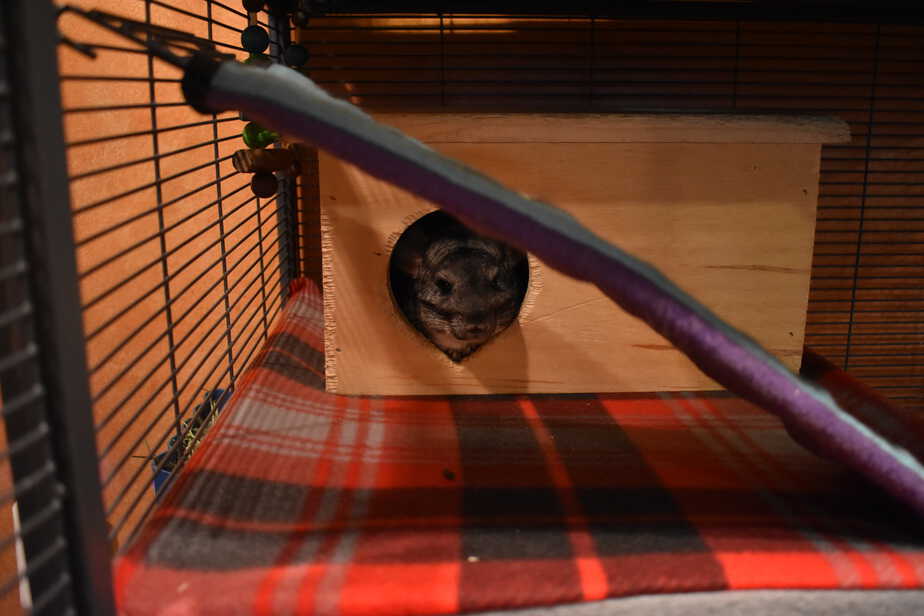
They are soft, remove the hard surfaces, and cover all ramps and stairways, reducing any chance of a foot injury and diseases like bumblefoot.
I also love that you can simply vacuum the cage (or sweep it out) and then wash the liners 1 to 2 times per week to have the cage completely fresh.
If you double whammy this notion with teaching your chinchilla to urinate in a litter pan, you are going to be in crazy good shape when it comes to never dealing with a smell coming from your chinchilla or the cage.
Seriously, spend the few extra bucks, never buy bedding again, and have an awesome looking customized cage.
I currently use and love the Piggy Bed Spread Liners.
- Designed specifically for Critter Nation Cage
- Includes: Two large pan liners (one with a notch/cut-out for the ramp opening, Two small shelf liners and three ramp covers
- Available in various designs
I am entering year 5 with my chinchilla and still have my original set and have only purchased 1 other set as a backup.
I also purchased the second set as an additional color option, but mainly because I sometimes have busy weeks and the backup-set makes it easy to clean the cage, swap the liners and wash the others on my own schedule, instead of having to get them done during a play session.
They are awesome. End of story.
Add Essential Accessories To The Cage
This may be arguably the most fun part of setting up your chinchilla cage. I love placing the “furniture” inside of the cage, which includes any essentials, in addition to toys and accessories.
When it comes to essentials, you have several items.
I will also explain the importance of each and why it is critical to include them in your chinchilla cage. Here is a look at those.
The Nest/Hiding Box
The nest and hiding box may arguably be the most critical item of the equation. It is your chinchilla’s safe place inside of the cage.
Clearly, they should not fear you after some time passes, but that does not mean other things will not startle your chinchilla.
Vacuums, visitors, or even another pet entering the room can all induce fear. The hiding box is where they can go if they scared. Or if they just want a safe place to sleep.
That said, something like the vacuum won’t cause fear if it is something your chinchilla hears regularly. Read “Do Chinchillas Like Vacuums?” for more on this.
My chinchilla, even after 5 years, still sleeps in her nesting box all the time. If you are on a budget, skip a few toys at first, but make sure you buy the hiding box right out of the gate.
You can learn more about the nest boxes/hiding boxes I recommend here.
Water Bottles
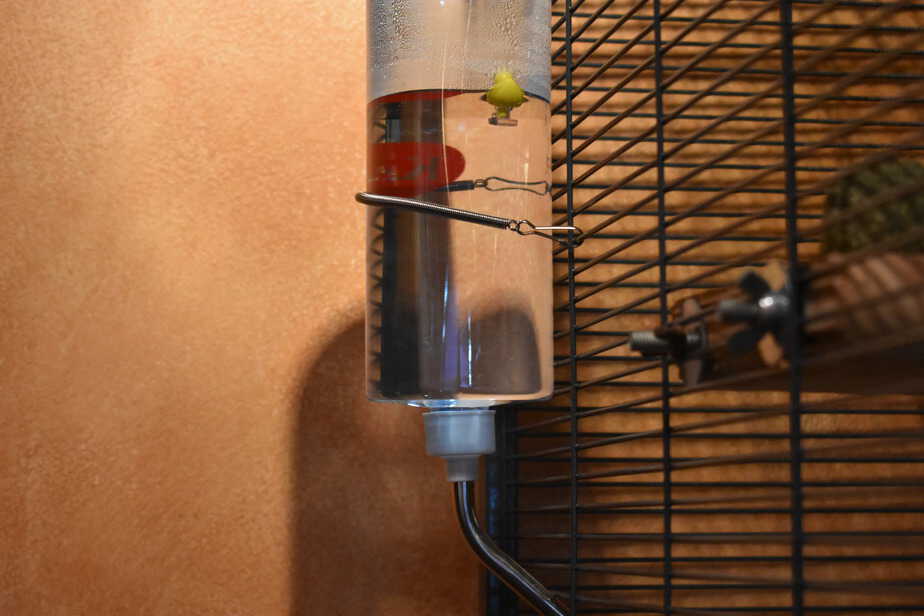
Next, you absolutely need to have a water bottle attached to the cage. While it may seem like overkill, I honestly recommend two large water bottles attached to the cage and always filled with clean, non-well water.
Preferably, buy gallon jugs of purified water that you can get for 1.00 at any store. Chinchillas always need unlimited access to water.
I currently use the Lixit water bottles and love them. They do not clog and work fantastic. Not to mention, they attach in about 5 seconds. You can read my other recommendations for water bottles here.
Food Bowl
Hey, they need to eat, right? The food bowl will only be used for pellets, which is one of the main recommended food sources for chinchillas.
The other main food source, the hay, goes inside hay feeders (see the next section). Check out my recommendations for the best food bowls here.
Hay Feeders

Your hay feeders are the last must-have item. You definitely don’t want to skip this, unless you plan to hand feed your chinchilla for the next 15 years.
That was a joke. You can view the hay feeders that I recommend here.
That wraps up what I would consider the essentials when it comes to setting up a chinchilla cage.
However, learning how to set up a chinchilla cage in the best fashion possible also requires you to add some fun, personality, and taste to the cage.
This includes accessories and toys. Let’s dive into those options next.
Add Optional (But Highly Recommended) Accessories
Accessories are part of setting up your chinchilla cage. It is tough to tell you the exact accessories you should get because every chinchilla and every chinchilla cage is going to be different.
Some accessories, however, I strongly recommend. In a nutshell, I recommend these accessories at a minimum:
- A chinchilla hammock (learn more here)
- Chinchilla chew sticks (learn more here)
- Tunnels and ramps
Outside of these, you can put your own twist on the chinchilla cage and add whichever accessories you prefer, assuming that they are safe.
Plan Out Cage Cleanings
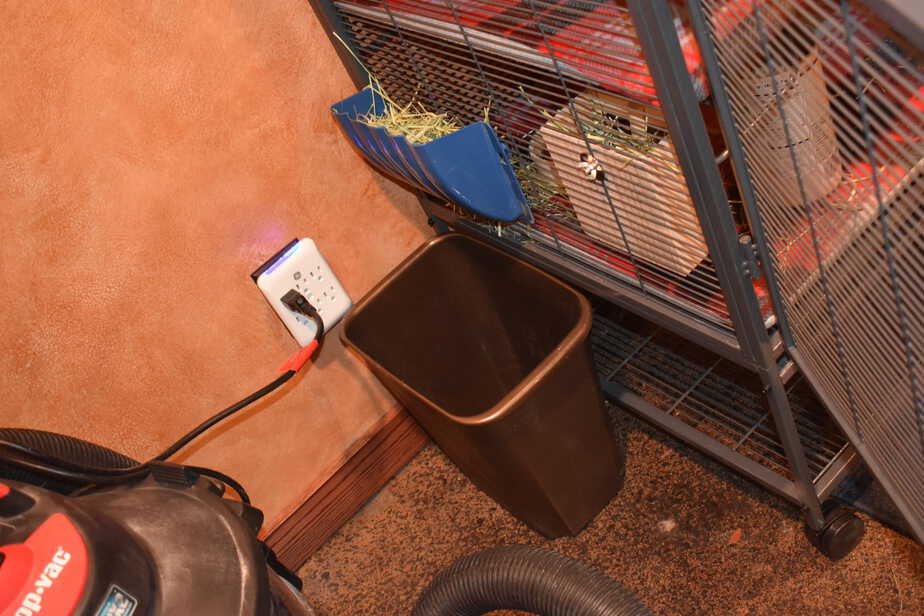
This may not fall directly into setting up a chinchilla cage, but I believe it is still important to mention.
Learning how to set-up a chinchilla cage correctly does require you to understand how to clean the cage properly. You can learn by reading my full post about cleaning a chinchilla cage here.
Plan out your cleanings and make it a routine. No matter how good of a cage you set up for your chinchilla, a dirty cage is never going to be a good cage for your chinchilla.
Dirty cages can lead to your chinchilla getting lice, or various diseases and infections. You don’t want to live in a filthy house, so why should your pet?
Setting Up A Chinchilla Cage: Final Thoughts
Hopefully, after reading this brief post about how to set up a chinchilla cage, you realize that it is not overly difficult to set one up and add the necessary (and desired) items.
With some planning and a few purchases following my recommendations, you will have your chinchilla’s cage set up and in great working order in no time.
Chili and I wish you the best of luck setting up your new chinchilla cage and the best of luck with your new chinchilla and the journey you have ahead of you.
Share your thoughts.
Do you have any other recommendations about how to set up a chinchilla cage in the best fashion?
Any other accessories or toys you would recommend adding?
Be sure to share those thoughts, stories, and concerns by dropping a comment below.
As always, Chili and I appreciate you stopping by today and reading, and we will see you again next time.

Leave a Reply